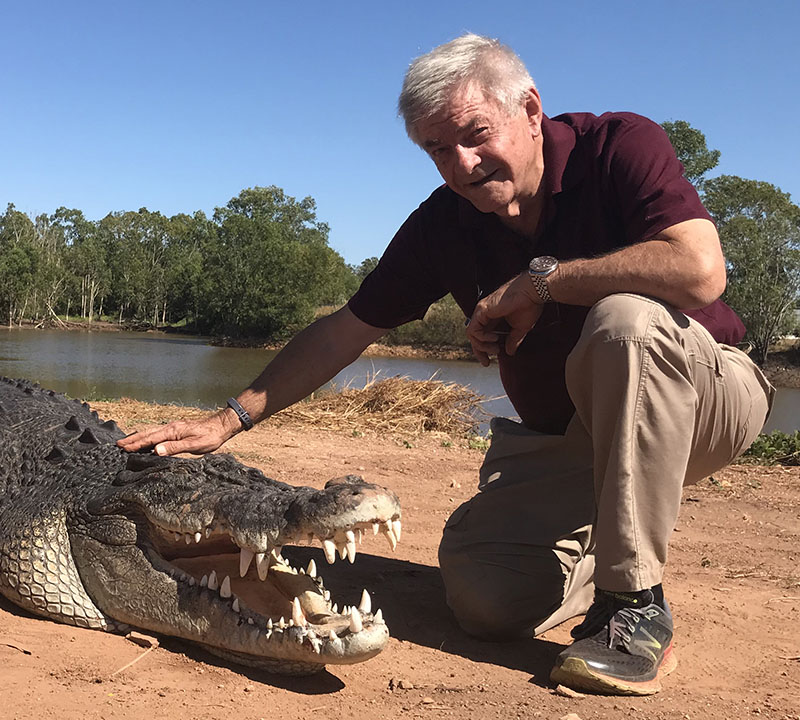In a philosophical mood in 2001, pioneering zoologist Professor Grahame Webb AO reflected that “there is something awesome about the potential of people, if given a sound and worldly education”. The poetic piece entitled The Fences of Life ruminated on how ‘fences’ enclosing our personal spaces can constrain our thinking.
Arriving at UNE in 1965, 18-year-old Grahame was met with various scientific ‘fences’, but it is also where he found “massive freedom” to explore and learn, and boldly climb them. “Posing questions and trying to answer them – that was my scene – and it all started in the Zoology Department at UNE,” Grahame says. “Freewheeling ecologist Hal Heatwole had a big influence and opened the floodgates; I must have driven him crazy. I took every opportunity to go on his and other field trips and expeditions, just to get experience.
“There was an Exploration Society in those days and I signed up for a trip to Macquarie Island, assuming it was on the Great Barrier Reef (GBR). I was surprised to receive an acceptance letter from the Australian Antarctic Division, and ended up spending four months down there working on seals and penguins.
“At UNE, while completing my PhD (on thermal relations in reptiles) and Honours (on reptile heart anatomy, earning a University Medal), I worked on various GBR islands, in the Gulf of Carpentaria and in Sturt’s Stony Desert. We did a lot of field work in the New England, too. We would go out practically every weekend collecting lizards and frogs and snakes. It was fantastic for a person like me. I loved every minute.”
During the career that unfolded, Grahame would work all over the world – on everything from kangaroos and sharks to sea turtles, monkeys, tuna and whales – but it is his progressive research into crocodile conservation and management that has defined his life.
Just before graduating with his PhD, the field skills Grahame developed at UNE led to him relocating to the “unfettered” Top End of the NT, as part of a University of Sydney crocodile research program.
“I only intended to stay for a short time. So little research had been done on even the basic biology of crocodiles that I thought I could make a sound contribution and move on,” Grahame says from his Darwin home of 50 years. Instead, he “published a lot of field research” that broke new ground, established the consultancy Wildlife Management International (in 1978), and Crocodylus Park – one of Darwin’s premier tourist attractions since 1994 – to support his ongoing research and public education efforts.
Working closely with First Nations peoples to catch and mark crocs, Grahame gained valuable insights into safe handling procedures as well as traditional culture, which informed future projects and collaboration with Indigenous people in the Amazon and Arctic. He also demonstrated that sustainable saltwater crocodile ranching and farming could provide commercial incentives to conserve a serious predator – an approach that has been applied within wildlife management programs internationally.
A 1980 “reptilian menace” novel (Numunwari) Grahame wrote, about a gigantic rogue croc and keeper of ancient secrets – a modern-day fable inhabited by ruthless criminals, opportunistic politicians and wise custodians – may not have commanded literary acclaim, but was made into the feature film Dark Age.
In 2001 Grahame was recognised with the Clunies Ross National Science and Technology Award for his scientific contributions and inspirational leadership. Earlier this year he was also made an Officer of the Order of Australia for distinguished service to environmental conservation and wildlife preservation.
Over the decades, WMI has supported more than 50 conservation management programs globally and Grahame has advised a multitude of organisations, including CITES and the IUCN. His once controversial conservation strategies, incorporating science and enterprise with traditional Indigenous management, are now much more mainstream.
“I have always worked for outcomes rather than accolades,” Grahame says. “It has ruffled some feathers because conservation is political as well as scientific. But good science in isolation can be dangerous because solutions have social consequences. With crocodiles, there are so many stakeholders, and biological, social and economic issues.”
Grahame has only once been bitten by a croc – on the leg in 1986, while collecting eggs – but very soon learnt three prerequisites for working with one of the oldest and most deadly animals on the planet: “You need to be able to run, jump or climb when something goes wrong”.
Still, the animals have earned Grahame’s admiration and respect. “Crocs are tenacious survivors,” he says. “Even after the period of intensive, unregulated hunting from 1945-71 in the Northern Territory, when 99% of crocs were taken out, populations bounced back. Crocodiles have been very successful as a species.”
But don’t expect to hear Grahame lumping praise on his own scientific career. “Humbleness can and should be the major driver for people in science,” he says. “A French scientist, Marie Eugene Chevreul, on his 100th birthday in 1886, summarised it perfectly: scientists should strive to be infallible, without claiming to be. You have to talk straight, stand up if you think you’re right, of course, but always be humble enough to accept you are wrong if sound evidence justifies it. Tolerance, respect and understanding of different peoples and cultures is equally important. I feel just as at ease working with Indigenous person as I do with politicians or businessmen worth billions of dollars.”
Having a rural upbringing (in Condobolin) and attending a rural university has had a big bearing on his career. “UNE’s rural location is an enormous strength,” Grahame says. “Rural people are problem-solvers, not problem-wallowers – they have to be. UNE opened doors for me and, without a shadow of a doubt, gave me the platform to do what I have done since.”


